El UH-1 "Iroquois" es un helicóptero militar ligero polivalente y utilitario. Más conocido como "Huey" por su denominación original "HU-1", el UH-1 es uno de los helicópteros más emblemáticos del mundo. El Huey, pilar de las fuerzas estadounidenses en la guerra de Vietnam, saltó a la fama tras sus papeles protagonistas en las superproducciones de Hollywood The Deer Hunter (1978) y Apocalypse Now (1979).
Conocido como "slick", la misión principal del Huey era introducir y extraer tropas de combate. Los asaltos aerotransportados en Vietnam solían consistir en hasta 10 slicks que transportaban infantería, con dos o tres helicópteros artillados que proporcionaban protección y un helicóptero de mando y control "Charlie/Charlie" que orbitaba sobre ellos. Las otras misiones del Huey incluían el abastecimiento avanzado, la búsqueda y rescate (SAR), el reconocimiento y la evacuación médica (Medevac) de tropas heridas. El UH-1H puede transportar 4000 libras de armas y carga, incluyendo hasta 14 tropas de combate o 6 camillas. Armado con cohetes y ametralladoras, también puede actuar como cañonero ad hoc.
Desarrollado en la década de 1950, el UH-1 entró en servicio en marzo de 1961. El UH-1H con el motor Lycoming T53-L-13 de 1.400 CV (1.000 kW) es la variante más producida de los más de 16.000 aparatos que se han construido desde entonces. El Huey sigue prestando servicio en todo el mundo, tanto en el ámbito militar como en el civil.
El DCS: UH-1H presenta un modelo actualizado del helicóptero armado con cohetes y ametralladora M134 de seis cañones montados en la puerta. La simulación ofrece un magnífico modelado de vuelo y sistemas. El útil modo Vuelo Fácil y otros modos reducen la curva de aprendizaje para los nuevos jugadores. Las posiciones de los jugadores incluyen piloto, copiloto y artilleros de puerta. Se incluye una campaña hecha a mano, así como una serie de misiones individuales y un curso de formación.
El UH-1, un caballo de batalla robusto y fiable, despierta un enorme afecto entre las antiguas tripulaciones. Cuando lo vueles, entenderás inmediatamente por qué.
Many custom audio samples of actual UH-1 sounds were taken specifically for this project by a number of UH-1 operators and affiliates in an effort to faithfully represent and immerse the player in the audio environment of the helicopter. Inside and outside the cockpit, the sound environment is filled with handcrafted audio that includes the main rotor, tail rotor, engine components, various cockpit systems, and weapons.
DCS: UH-1H Huey features an accurately reproduced, highly detailed and interactive 3D cockpit with six-degrees-of-freedom ("6DOF") technology that allows the player to move the viewpoint in any direction inside the cockpit space. This means you can not only look up, down, left and right, but also raise or lower your viewpoint, slide to either side, move closer or further from the instrument panel, and even tilt left or right.
Nearly all of the onboard systems of the helicopter are animated and functional, allowing the player to configure the systems in the cockpit by either using the mouse to click on the desired switches and controls or by using keyboard shortcuts that can be mapped to the player’s HOTAS.
The cockpit includes two color schemes – black and light grey, depending on the selected livery. For low light/night operations, fully adjustable internal lighting is available and includes two flood lights and a number of panel and instrument light controls.
The front instrument panel includes the primary flight indicators, engine instruments and a number of other indicators.
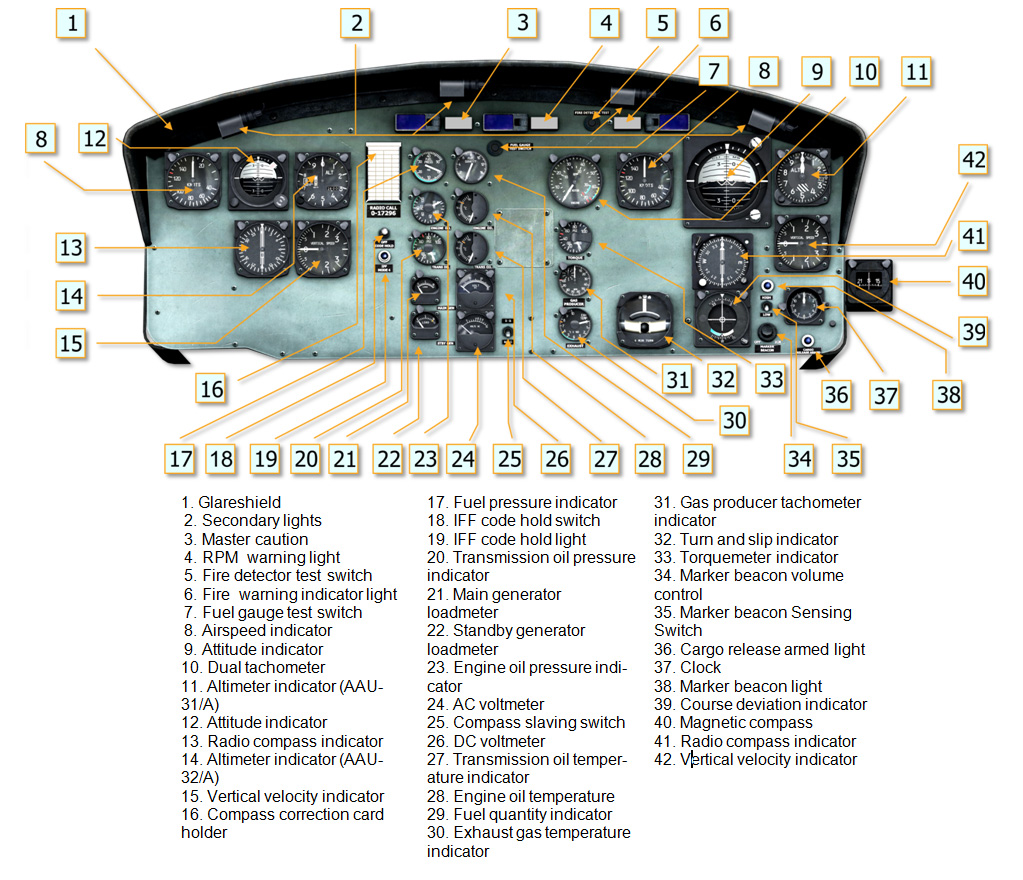
The Central Pedestal is positioned between the two pilots and contains a number of control panels to operate the radio systems, armament systems, engine fuel flow, force trim, and others. All of these controls are fully animated and functional in DCS: UH-1H Huey with the single exception of the transponder set, which is animated and can be configured, but has no function in the simulation.
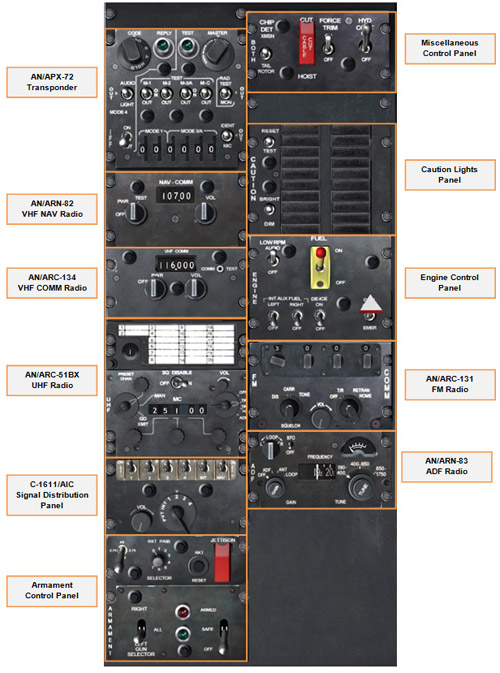
The Caution Lights Panel is subsystem of the Master Caution System and is used to indicate caution and warning signals to the pilot.
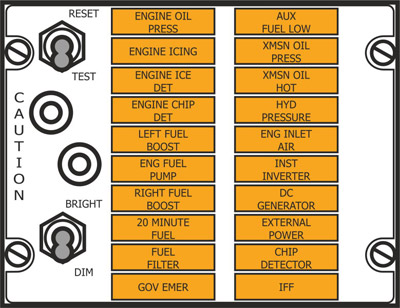
The Overhead Console contains controls for internal and external lighting, electrical power, and others. All of these controls are fully animated and functional in DCS: UH-1H Huey with the single exception of the Cabin Heating control panel, which is animated and can be configured, but has no function in the simulation.
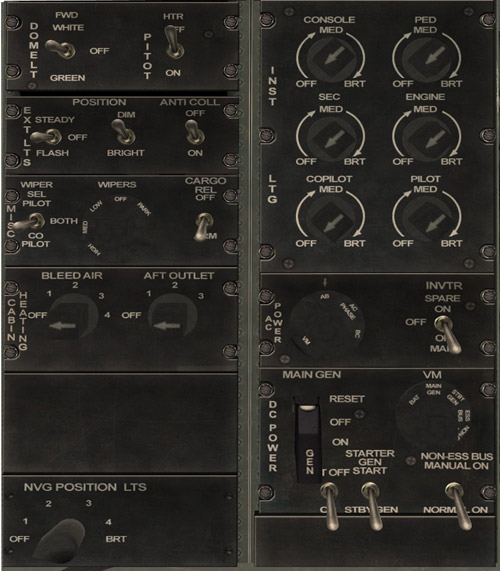
The flight control system is a hydraulically-assisted positive mechanical type, actuated by conventional helicopter controls. Complete controls are provided for both pilot and copilot. The system includes a cyclic system, collective control system, tail rotor system, force trim system, synchronized elevator, and a stabilizer bar.
The system is operated by the cyclic stick movement. Moving the stick in any direction will produce a corresponding movement of the helicopter which is a result of a change in the plane of rotation of the main rotor. The pilot cyclic contains the cargo release switch, radio ICS switch, armament fire control switch, hoist switch and force trim switch. Desired operating friction can be induced into the control stick by hand tightening the friction adjuster.
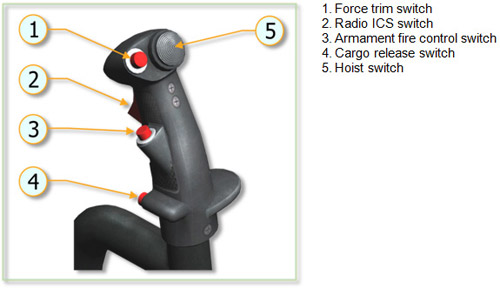
The synchronized elevator is located on the tailboom. It is connected by control tubes and mechanical linkage to the fore-and-aft cyclic system. Fore-and-aft movement of the cyclic control stick will produce a change in the synchronized elevator attitude. This improves controllability within the center of gravity (cg) range.
The stabilizer bar is mounted on the main rotor hub trunnion assembly in a parallel plane, above and at 90 degrees to the main rotor blades.

The gyroscopic and inertial effect of the stabilizer bar will produce a damping force in the rotor rotating control system and thus the rotor. When an angular displacement of the helicopter/mast occurs, the bar tends to remain in its trim plane. The rate at which the bar rotational plane tends to return to a position perpendicular to the mast is controlled by the hydraulic dampers. By adjusting the dampers, positive dynamic stability can be achieved, and still allow the pilot complete responsive control of the helicopter.








